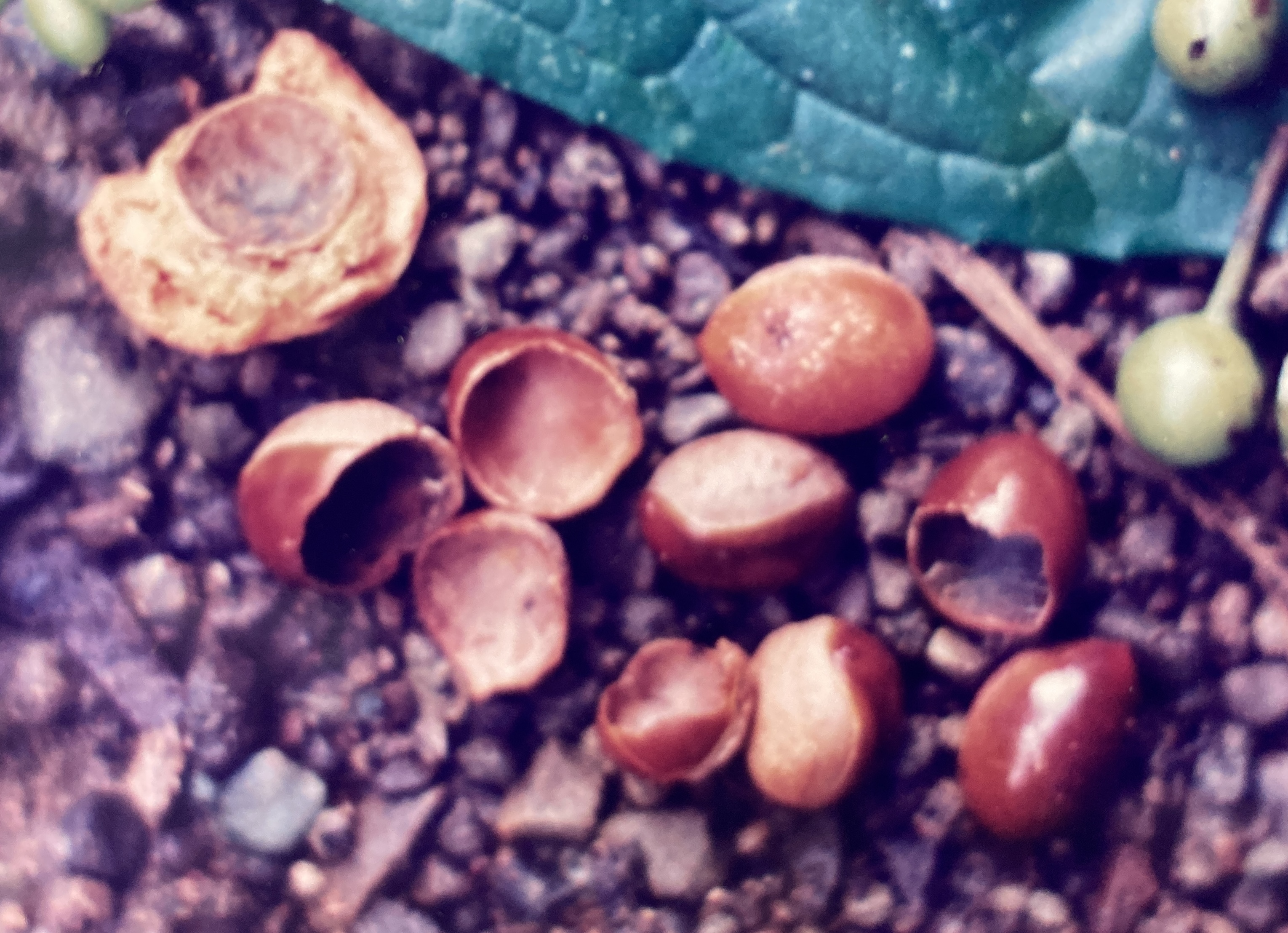Pouteria subrotata Cronquist
Sapotaceae
SAPOTE DE MICO
Rare evergreen understory or subcanopy tree (12-20 m) that prefers low-lying or riparian primary forest sites with poorly drained soils. P. subrotata has dark brown bark and a highly fluted, knobbed, and irregular trunk – characteristics that aid greatly in its identification. Though harvests are infrequent, the fruits of this species are small orbs that resemble tiny, reddish-orange tomatoes.
Description: P. subrotata is a small to moderately sized tree with a maximum trunk diameter of about 30 cm. Highly irregular, the nevertheless straight bole is often contorted along its entire length by deep, longitudinal grooves. Periodic, horizontally oriented swellings further punctuate the trunk, and these sometimes support thin sprouts or suckers. Low buttresses are visible at the base of the bole, while branching occurs along its upper half. These limbs produce a narrow, moderately dense crown of a single leaf layer. The mostly smooth bark is a rich, dark brown color and it may show some exfoliation in wide, vertical strips. P. subrotata‘s relatively large leaves are simple and alternately arranged. Variable in size, they range from 18-32 cm in length and from 8-11 cm in width. The blades are broadly elliptical (or sometimes slightly bulb-shaped) and lack (or possess only tiny) drip tips. Prominent primary and secondary veins, arranged pinnately, contrast darkly against the otherwise smooth, translucent blade tissue. The leaves sport markedly long petioles (3 cm), and these are green near the blade, turning brown and becoming swollen near their place of attachment to the twig. Most foliage is restricted to the branch tips, leaving the remaining sections of the limbs bare. New leaves are produced haphazardly during the dry season, at varying times between December and March.
Flowers grow in nearly sessile clumps from old (or sometimes current) leaf axils, and are thus largely located on the leafless sections of the branches. Each begins as a conical, tan-colored bud minutely mottled with maroon markings. Before opening, the pistil matures and protrudes from the tip of bud – presumably to receive pollen from other, already open, flowers and thus avoid self-pollination. The star-shaped blossom (0.5 cm) consists of five scaly sepals; five fused, white petals; five brown-anthered, forward curving stamens whose white filaments are attached to the petals; five backward curving, false stamens lacking anthers and located in the petal axils; a central stigma and style mounted on a round, green ovary; and a fine, yellow nectary that forms a ring around the pistil. P. subrotata does not blossom on an annual basis. During five years of observations (1989 to 1993), only one strong event was witnessed (1991), though another much weaker one was seen the following year. During active seasons, trees generate a series of two or three, well synchronized and short-lived bursts of flowers – all falling sometime between January and April – and separated by month-long intervals of infertility.
Fruits develop as glossy-green, nearly spherical drupes with indentations impressed into them at both ends. Distally, the old pistil is retained inside a small, crater-like depression while proximally, the fruit is attached to the branch by a thick, woody twig (0.5 cm). Hidden within the fruit’s superior indentation, this twig is invisible, making the drupe appear to be sessile. Mature fruits (2 cm) ripen slowly as they turn a deep russet color that is mottled by fainter yellowish bands. Inside, a thin, tomato-like skin protects a thicker layer of pasty pulp and a single seed. Distinctive, the ovoid seed (1.5 cm) sports a hard, extremely glossy, and coffee-brown coat whose continuity is broken only by the typical, buff-colored Sapotaceae seed scar. Harvests are rare events (only one having occurred in five years of observations) of moderate proportions, lasting from late July trough early September. Seeds germinate immediately, with the first, two-leafed seedlings visible in the soil by late August.
Similar Species: Based only on the form of its broadly elliptical, long-petioled foliage, P. subrotata could be confused with Chimarrhris latifolia as well as with Guettarda macrosperma. Fortunately, these latter species possess an opposite leaf arrangement and should not cause more than momentary doubt. When identifying this species, look for its small stature, its irregular, dark brown trunk as well as its unusually broad leaves with long petioles.
Natural History: P. subrotata flowers are visited by bees and insects. By staggering the temporal development of their male and female parts, these blossoms demonstrate a strategy (common among the Sapotaceae) designed to avoid self-pollination. Maturing early, the P. subrotata pistil protrudes from the flower bud, allowing it to receive pollen liberated by the mature anthers of other blossoms.
The fruits of this species are harvested by arboreal mammals. Interestingly, P. subrotata seeds are preyed upon as well, for large numbers of empty, cracked seed coats are found underneath these trees during harvests. Though not observed, the animal responsible for this behavior could be a strong-billed bird such as a parrot.
Distribution: In Manuel Antonio National Park (MANP), P. subrotata is found along streambanks and in low-lying forests were soils are water-saturated. In Costa Rica, this species has been sighted in Punta Leona, the Carara Biological Reserve, and the Sirena Post of Corcovado National Park. It ranges from Nicaragua to northern Venezuela and Amazonian Peru.
Images: Trunk. Trunk2 Flower. Leaves & Immature Fruit Fruit. Fruit2. Seeds




